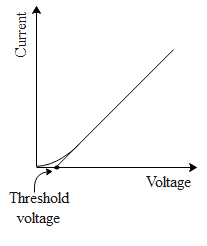
The threshold voltage of Si and Ge are
a) Si : 0.7V and Ge : 0.3V
b) Si : 1.1V and Ge : 0.5V
c) Si : 0.3V and Ge : 0.7V
d) Si : 0.5V and Ge : 1.1V
Answer
570k+ views
Hint: The Si(silicon) and Ge(germanium) are the semiconductors. The threshold voltage of a semiconductor is nothing but the value of voltage applied across the semiconductor for which the current across it varies as per the ohm's law. Different semiconductors have different values of threshold voltage. We will state the values of this voltage for silicon as well as germanium.
Complete step-by-step answer:
When a diode such as silicon or germanium is connected across a battery, initially the current increases very slowly almost negligibly till the voltage across the diode crosses a certain value called as the threshold voltage or the cut-in-voltage. After this point, the voltage and the current vary as per the ohm's law. Given below is the graph which depicts the following.

The threshold voltage is given as the tangent to the point where the voltage just shoots up exponentially. For different materials of the diode, the threshold voltage is different. For silicon the threshold voltage is about 0.7V and for germanium it is about 0.3V.
So, the correct answer is “Option A”.
Note: Before the threshold voltage the current increases by a very small amount. This is because the depletion layer plays a dominant role in controlling the motion of the charge. Since the width of the depletion layer is different for each of the semiconductors, therefore the threshold voltage for each of the semiconductors is different. It is to be noted that the extrapolated line across the variation of the voltage or also called as the extrapolated threshold voltage.
Complete step-by-step answer:
When a diode such as silicon or germanium is connected across a battery, initially the current increases very slowly almost negligibly till the voltage across the diode crosses a certain value called as the threshold voltage or the cut-in-voltage. After this point, the voltage and the current vary as per the ohm's law. Given below is the graph which depicts the following.

The threshold voltage is given as the tangent to the point where the voltage just shoots up exponentially. For different materials of the diode, the threshold voltage is different. For silicon the threshold voltage is about 0.7V and for germanium it is about 0.3V.
So, the correct answer is “Option A”.
Note: Before the threshold voltage the current increases by a very small amount. This is because the depletion layer plays a dominant role in controlling the motion of the charge. Since the width of the depletion layer is different for each of the semiconductors, therefore the threshold voltage for each of the semiconductors is different. It is to be noted that the extrapolated line across the variation of the voltage or also called as the extrapolated threshold voltage.
Recently Updated Pages
Master Class 12 English: Engaging Questions & Answers for Success

Master Class 12 Economics: Engaging Questions & Answers for Success

Master Class 12 Social Science: Engaging Questions & Answers for Success

Master Class 12 Maths: Engaging Questions & Answers for Success

Master Class 12 Chemistry: Engaging Questions & Answers for Success

Master Class 12 Business Studies: Engaging Questions & Answers for Success

Trending doubts
What are the major means of transport Explain each class 12 social science CBSE

Which are the Top 10 Largest Countries of the World?

Draw a labelled sketch of the human eye class 12 physics CBSE

Explain sex determination in humans with line diag class 12 biology CBSE

The pH of the pancreatic juice is A 64 B 86 C 120 D class 12 biology CBSE

Explain sex determination in humans with the help of class 12 biology CBSE




